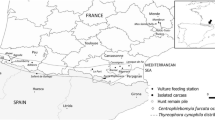Summary
Accessory (supernumerary) antlers are an infrequent phenomenon in male cervids. These bony protuberances grow mostly from permanent pedicles, which developed in response to a repeated or a severe trauma to frontal, nasal or parietal bones. They regularly undergo seasonal mineralization, casting and regrowth and may persist for many years. Three examples of accessory antlers in telemetacarpal cervids, roe deer (Capreolus capreolus), white-tailed deer (Odocoileus virginianus) and moose (Alces alces), are presented. The initiation of accessory antlerogenesis, the progress of growth and development, and the mineralization and casting of accessory antlers were mostly identical or similar to processes observed in the antlerogenesis of lateral antlers. The antlerogenic property of the competent periosteum, located within the “antler territory”, appears to play a crucial role in the development of accessory antlers. The variability in location and the progress of development of accessory antlers, which were observed in several antlerogenic cycles, is discussed in relationship to the origin of deciduous antlers in extinct ancestors of cervids.
Zusammenfassung
Gelegentlich treten bei männlichen Cerviden akzessorische (überzählige) Geweihstangen (sog. Nebenstangen) auf. Zumeist wachsen diese knöchernen Protuberanzen von permanenten Rosenstöcken, die als Folge wiederholter Verletzungen der Frontalia, Nasalia oder Parietalia entstanden sind. Die überzähligen Geweihstangen werden periodisch mineralisiert, abgeworfen und regeneriert und können über mehrere Jahren existieren. Drei Beispiele solcher Nebenstangenbildungen bei telemetacarpalen Cervidenarten (Reh,Capreolus capreolus; Weißwedelhirsch,Odocoileus virginianus; Elch (Alces alces) werden besprochen. Beginn und Verlauf des Nebenstangen-Wachstums sowie Mineralisation und Abwurf der Nebenstangen entsprachen zumeist weitgehend den entsprechenden Vorgängen an den Hauptstangen. Die Fähigkeit des kompetenten Periostes des „Geweihbildungsfeldes“ zur Genese von Geweihstrukturen spielt eine entscheidende Rolle bei der Bildung akzessorischer Geweihstangen. Die unterschiedliche Lokalisation der Nebenstangen und deren unterschiedliche Entwicklungsgeschwindigkeit während verschiedener Geweihzyklen werden im Hinblick auf die Entstehung von periodisch gewechselten Geweihen bei den ausgestorbenen Vorläufern der Cerviden diskutiert.
Résumé
Des bois accessoires (surnuméraires) constituent un phénomène peu fréquent chez les Cervidés mâles. Ces protubérances osseuses procèdent le plus souvent de pivots permanents qui se développent en réponse à un traumatisme sévère causé aux os frontaux, nasaux ou pariétaux. Ils présentent normalement une minéralisation saisonnière, une mue et une nouvelle croissance et peuvent persister plusieurs années. Trois exemples sont présentés de merrains accessoires observés chez des Cervidés télémétacarpaliens, soit chez le Chevreuil européen (Capreolus capreolus), chez le Chevreuil à queue blanche (Odocoileus virginianus) et chez l'Elan (Alces alces). L'initiation de la genèse de bois accessoires, la progression de leur croissance et de leur développement ainsi que leur minéralisation et leur chute se révélèrent essentiellement identiques ou similaires aux processus observés dans la genèse de bois principaux. La faculté, pour le périoste concerné, situé au c∄ur de l'espace territorial des bois, de générer des bois semble jouer un rÔle crucial pour le développement de merrains accessoires. La localisation variable et la progression du développement de merrains accessoires, lesquels ont été observés dans de nombreux cycles de bois, fait l'objet d'une discussion en relation avec l'origine de bois caducs chez des ancÊtres de Cervidés aujourd'hui éteints.
Similar content being viewed by others
References
Bubenik, A., 1966: Das Geweih. Hamburg: Parey.
Bubenik, A., 1990: Epigenetical, morphological, physiologial, and behavioral aspects of evolution of horns, pronghorns, and antlers. In:Bubenik, G. A.;Bubenik, A. B. (eds.) Horns, pronghorns and antlers, New York: Springer, pp. 3–113.
Bubenik, G. A., 1990a: Neuroendocrine regulation of the Antler Cycle. In:Bubenik, G. A.;Bubenik, A. B. (eds.) Horns, pronghorns and antlers. New York: Springer, pp. 265–297.
Bubenik, G. A., 1990b: The role of the nervous system in the growth of antlers. In:Bubenik, G. A.;Bubenik, A. B. (eds.) Horns, pronghorns and antlers. New York: Springer, pp. 339–358.
Goss, R. J. 1983: Deer antlers. Regeneration, function and evolution. New York: Academic Press.
Goss, R.J., 1990: Of Antlers and embryos. In:Bubenik, G. A.;Bubenik, A. B. (eds.) Horns, pronghorns and antlers. New York: Springer, pp. 298–312.
Hartwig, H.;Schrudde, J., 1974: Experimentelle Untersuchungen zur Bildung der primären Stirnauswüchse beim Reh (Capreolus capreolus L.). Z. Jagdwiss.20, 1–13.
Jaczewski, Z., 1990: Experimental induction of antler growth. In:Bubenik, G. A.;Bubenik, A. B. (eds.) Horns, pronghorns and antlers. New York: Springer, pp. 371–395.
Kierdorf, H.;Kierdorf, U., 2001: The role of the antlerogenic periosteum for pedicle and antler formation in deer. In:.Sim, J. S.;Sunwoo, H. H.;Hudson, R. J.;Jeon, B. T. (eds.) Antler science and product technology. Edmonton: ASPTRC, pp. 33–51.
Li, C.;Suttie, J. M., 2001: Deer antler generation: A process from permanent to deciduous. In:.Sim, J. S.;Sunwoo, H. H.;Hudson, R. J.;Jeon, B. T. (eds.) Antler science and product technology. Edmonton: ASPTRC, pp. 15–31.
Nellis, C. H., 1965: Antler from right zygomatic arch of white-tailed deer. J. Mammal.46, 108–109.
Wislocki, G. B., 1952: A possible antler rudiment on the nasal bones of a white-tailed deer (Odocoileus virginianus borealis). J. Mammal. 33, 73–76.
Author information
Authors and Affiliations
Rights and permissions
About this article
Cite this article
Bubenik, G.A., Hundertmark, K.J. Accessory antlers in male Cervidae. Zeitschrift für Jagdwissenschaft 48, 10–21 (2002). https://doi.org/10.1007/BF02285353
Received:
Accepted:
Published:
Issue Date:
DOI: https://doi.org/10.1007/BF02285353
Key words
- Accessory antler
- antlerogenic periosteum
- antler development
- roe deer
- white-tailed deer
- moose
- cervid evolution
Schlüsselwörter
- Akzessorische Geweihstangen
- Geweihbildungsperiost
- Geweihbildung
- Reh
- Weißwedelhirsch
- Elch
- Cerviden-Evolution




